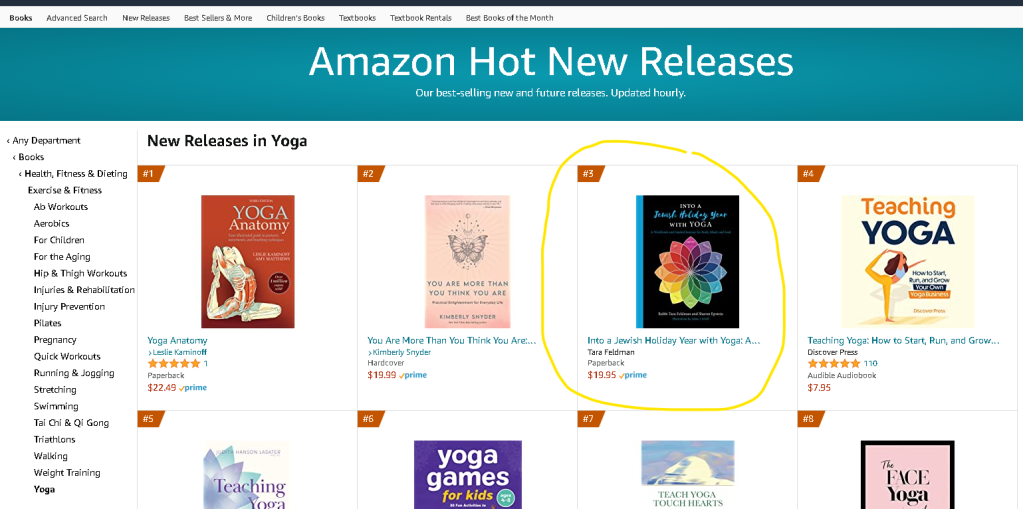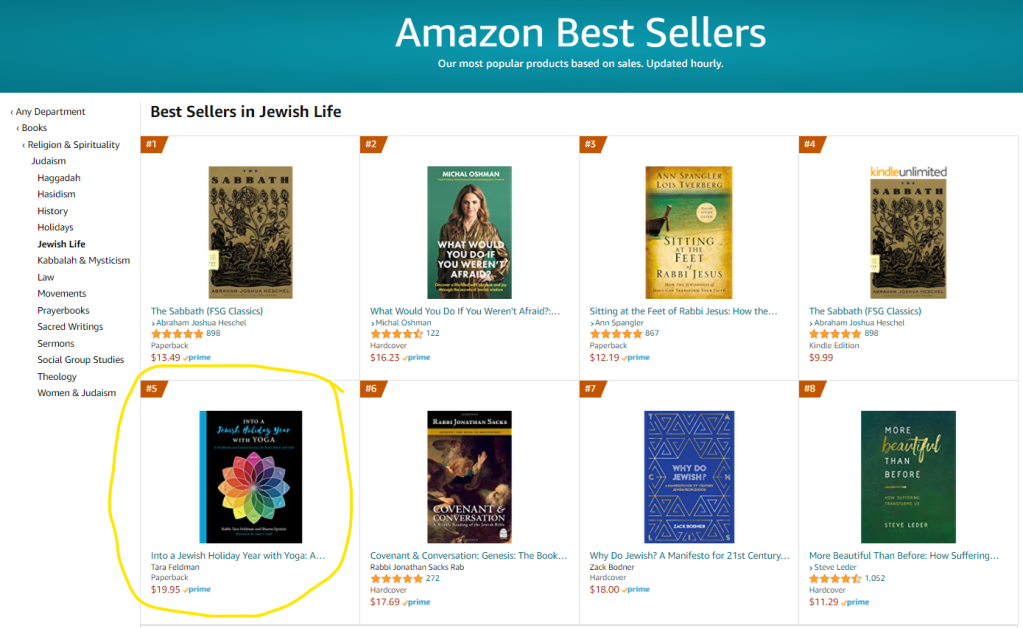In January of 2021, I was tagged by some friends into a Facebook thread from the illustrious Delia Sherman, on behalf of a friend looking for a graphic designer to help produce a self-published book with some Hebrew in it. Since that’s totally my niche, I was pleased when the co-author reached out to me the next day for some more information. That was my introduction to yoga teacher Sharon Epstein, her rabbi Tara Feldman, and their book project, which would become a labor of love for me as well: Into a Jewish Holiday Year with Yoga: A Workbook and Guided Journey for Body, Mind, and Soul (2021; ISBN 979-8-9850271-0-5; USD $19.95).
The ikar, or kernel, of the book is that these two delightful and insightful women have teamed up to structure a yoga experience around the Jewish holiday cycle. For each of 12 holidays, they had put together some basic introductory context, then drawn out a deep underlying conceptual theme, and matched it with a set of yoga poses to literally embody that theme. They also provided a guided meditation and some journaling prompts to round out the internal experience of each holiday.
Mind you, I have spent a total of about 2 hours on a yoga mat in my life, but I have a visceral appreciation for the rhythms of the Jewish calendar. We are souls and we are bodies. Bringing together the spiritual and the somatic brings depth to both perceptions. It was a real gift to get to be a part of this project and help Sharon and Tara activate its full potential.

Over the ensuing 10 months, the book format went from an 8″ square gift book to a 6×9″ paperback and finally to an 8.5×11″ workbook. Still, I had a clear vision all along for the cover art: a 12-spoked color wheel that would encompass the 12 holidays covered in the book.
In terms of the typefaces, I started with a classic Adobe pairing of Minion (serif for the body copy) and Myriad (sans-serif for the display type), including Myriad Hebrew for the few Hebrew words interspersed. Fortunately, however, once the authors realized I could handle the Hebrew easily, they decided to work more Hebrew back into the text, and we ended up choosing Shlomo for a more calligraphic feel. We also added an informal script face, John Benson’s Caliban, into the mix to enhance the display elements in English.
As part of the production process, I walked the authors through joining Amazon’s Kindle Direct Publishing program, so now I have that under my belt. We learned that Amazon lets you opt into a free ISBN assignment that can only be used internally to Amazon (since perpetuating their own monopoly is what they’re all about). But when I sought some advice from another friend, experienced Amazon author Zahara Schara, she strongly recommended investing in a real ISBN registration with R.R. Bowker, which allows you to exist in the real world of Books In Print and be found and sold in places outside the Amazon ecosystem. Note, however, that Bowker now charges $125 for a single ISBN registration, whereas you can purchase a block of 10 for $295 and use them as you need them (indefinitely—they never expire). As a frequent collaborator with self-published authors, this need has come up before, and I’ve often thought that I should go ahead and register that block of 10 ISBNs. Thus it came about that Schultz Yakovetz Judaica is now a registered “micropublisher” with R.R. Bowker, and Lev Shalem Yoga is its first official imprint. :-D
We had targeted November 1, 2021, as our publication date (just in time for a very early Chanukah 5782). After many, many fun and fruitful hours of Zoom meetings, page proofs, revisions, and a final Shehecheyanu blessing, we tied up all the loose ends in time to hit Publish on Sunday, October 31.
By the afternoon of November 1, the book had hit #3 on Amazon’s “Hot New Releases” in Yoga, and #5 on their Best Sellers list in the Jewish Life category… nestled in between Rabbi Abraham Joshua Heschel and Rabbi Lord Jonathan Sacks. This is incredibly august company to be in.
I’m very proud of this project, and grateful to the chain of friends who brought these two dynamic Jewish women into my life. PS: It goes without saying that this book will make the perfect Chanukah gift for your favorite Jewish yoga enthusiast. Order your copy now… or if you’re anywhere near Great Neck, NY, contact Sharon Epstein for a signed author copy.
Want more? You can “like” the book’s Facebook page, or join the Lev Shalem YOGA Facebook group (tell them Erica sent you).












